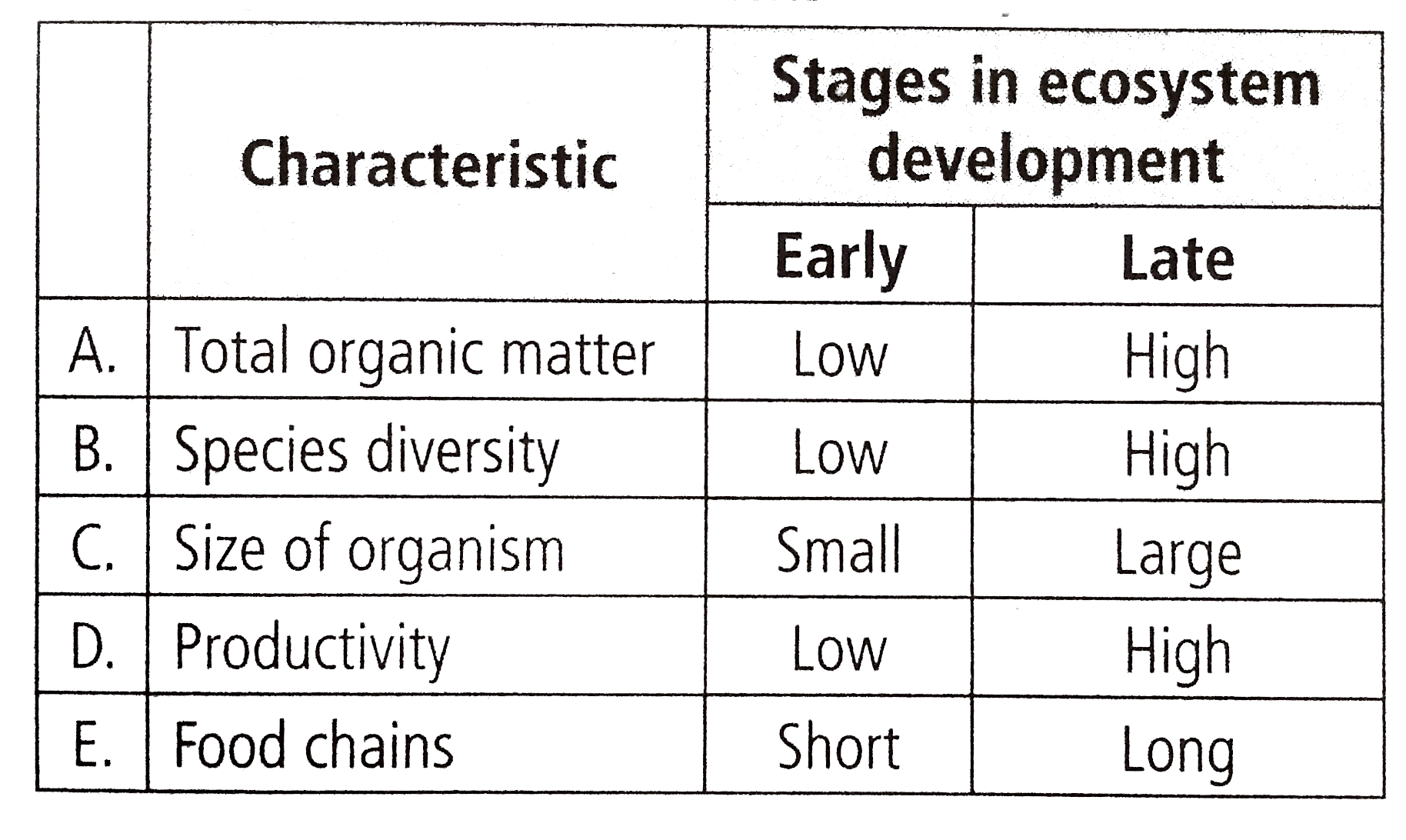Initial serial stages in succession
Possess low diversity
Have higher biomass
More numerous in secondary succession
Show maximum niche specialisation.
The correct Answer is:D
Step-by-Step Solution:
1. Understanding Succession: Succession is a natural process that occurs in ecosystems over time, leading to changes in species composition and community structure. It can be classified into two main types: primary succession and secondary succession.
2. Defining Initial Seral Stages: The initial seral stages refer to the early phases of succession, particularly in primary succession, where the environment is typically barren or has minimal life forms. These stages are characterized by pioneer species that are the first to colonize the area.
3. Characteristics of Initial Seral Stages:
- Low Diversity: In the initial seral stages, species diversity is generally low. This is because only a few hardy species can survive in the harsh conditions of a newly formed or disturbed environment.
- Low Biomass: The biomass, or the total mass of living matter, is also low in these stages. As the ecosystem develops, biomass tends to increase as more species establish themselves and grow.
- Pioneer Species: These are the first organisms to colonize the area. They are usually well-adapted to survive in extreme conditions and play a crucial role in modifying the environment, making it more hospitable for other species.
4. Comparing Primary and Secondary Succession:
- In primary succession, the initial seral stages occur on surfaces where no soil exists (e.g., after a volcanic eruption).
- In secondary succession, the initial seral stages occur in areas where a disturbance has destroyed an existing community but left the soil intact (e.g., after a forest fire).
5. Conclusion: The initial seral stages in succession are marked by low diversity and low biomass, primarily involving pioneer species that prepare the environment for subsequent species to thrive.
- Low Diversity: In the initial seral stages, species diversity is generally low. This is because only a few hardy species can survive in the harsh conditions of a newly formed or disturbed environment.
- Low Biomass: The biomass, or the total mass of living matter, is also low in these stages. As the ecosystem develops, biomass tends to increase as more species establish themselves and grow.
- Pioneer Species: These are the first organisms to colonize the area. They are usually well-adapted to survive in extreme conditions and play a crucial role in modifying the environment, making it more hospitable for other species.
- In primary succession, the initial seral stages occur on surfaces where no soil exists (e.g., after a volcanic eruption).
- In secondary succession, the initial seral stages occur in areas where a disturbance has destroyed an existing community but left the soil intact (e.g., after a forest fire).
Topper's Solved these Questions
- ECOSYSTEMBOOK - AAKASH INSTITUTE ENGLISHCHAPTER - ECOSYSTEMEXERCISE - Assignment (Section B)
35 Videos
- ECOSYSTEMBOOK - AAKASH INSTITUTE ENGLISHCHAPTER - ECOSYSTEMEXERCISE - Assignment (Section C)
66 Videos
- ECOSYSTEMBOOK - AAKASH INSTITUTE ENGLISHCHAPTER - ECOSYSTEMEXERCISE - Exercise
20 Videos
- DIGESTION AND ABSORPTION BOOK - AAKASH INSTITUTE ENGLISHCHAPTER - DIGESTION AND ABSORPTION EXERCISE - Assignment (SECTION-D Assertion - Reason Type Questions )
10 Videos
- ENVIRONMENTAL ISSUESBOOK - AAKASH INSTITUTE ENGLISHCHAPTER - ENVIRONMENTAL ISSUESEXERCISE - ASSIGNMENT SECTION D
15 Videos
Similar Questions
Knowledge Check
During the stages of succession in a given ecosystem, the following changes in characteristics may be observed.

Which one of the characteristics A,B,C,D or E is responsible for the apparent high degree of stability associated with a climax acosystem?ABBDCADEThe rate of secondary succession is faster than primary succession because.
Asoil or sediment is already presentBwater is availbale in large quantityCclimax community is already presentDpH of sol is favorable.
A: Neither the community modifies environment nor the environment forces the community to leave the palce in climax stage of succession.
R: Climax community is xerophytic in most of the types of succession.
View SolutionSuccession is :
View SolutionChoose the correct identification for the given stage of succession and is procceded by which stage respectively ?

View Solutionselect the correct sequence of stages in xerarch succession.
View SolutionFor the expansion occuring from initial to final stage in finite time, which is incorrect?
View SolutionEcological succession is
View Solution
